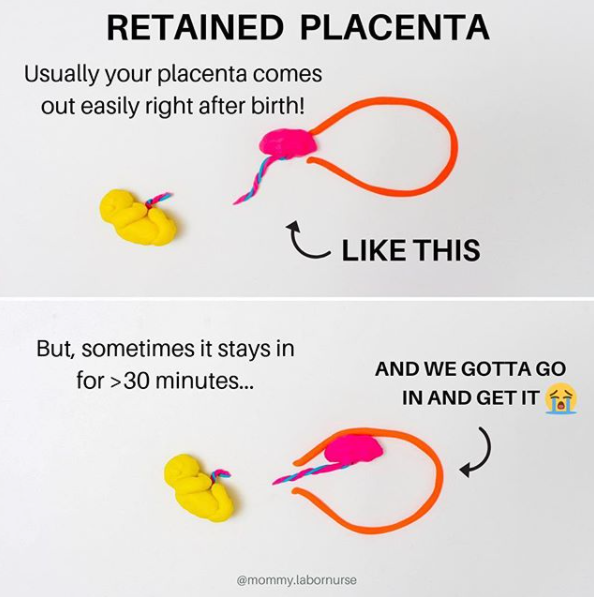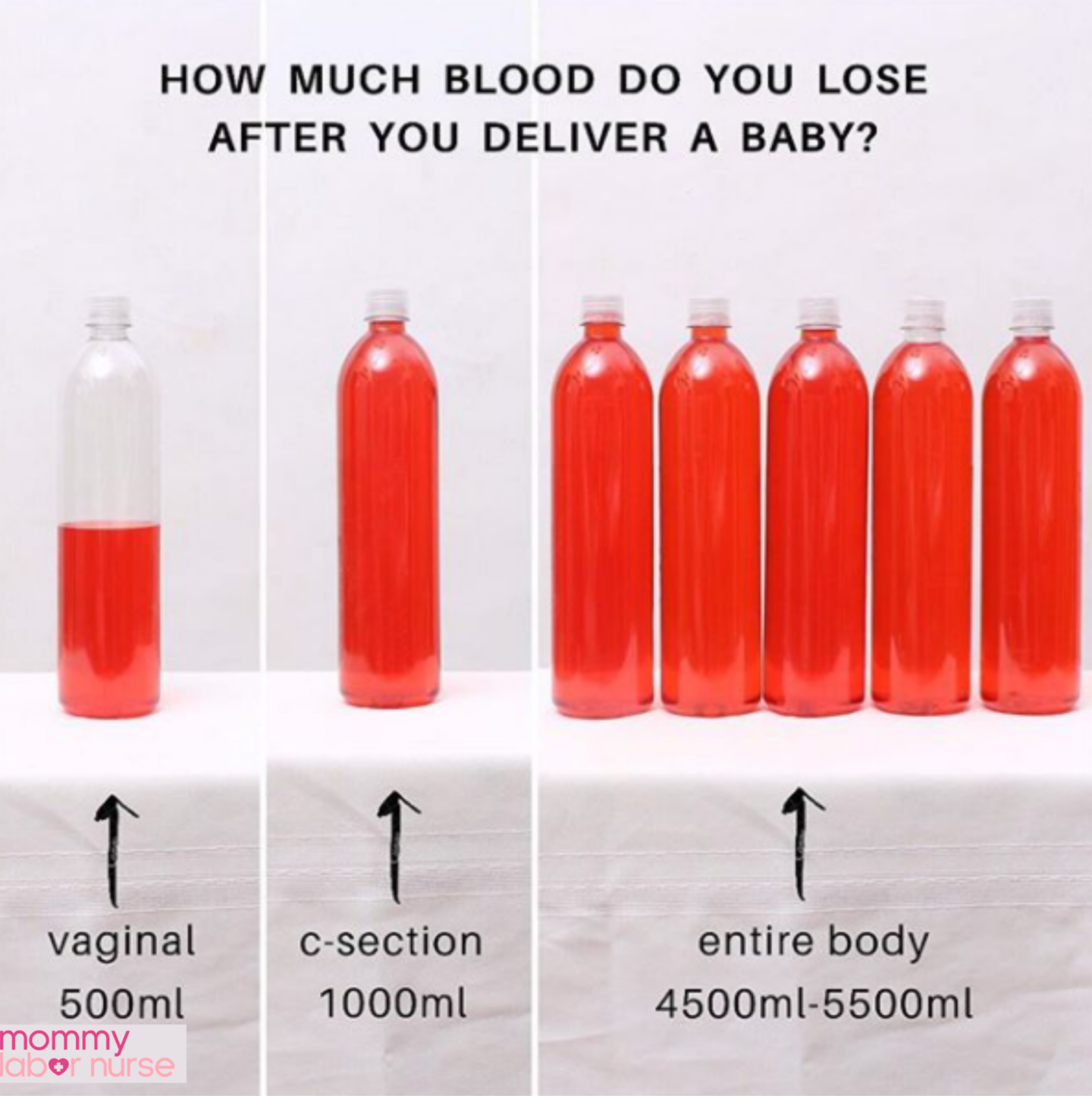Raise your hand if you knew there were FOUR STAGES of labor? I didn’t before I became a labor and delivery nurse!
Labor isn’t ALL contractions…and I’m about to tell you how it all will play out!
In short the four stages of labor look like this:
- Contractions
- Pushing and birth
- Delivering the placenta
- First 1-2 hours postpartum
But as I’m sure you can imagine, there’s a LOT to unpack in each of those four stages. I also want to talk a little more in-depth about contractions, too. So let’s get right into all of this, mama!
Follow @mommy.labornurse on Instagram to join our community of over 650k for education, tips, and solidarity on all things pregnancy, birth, and postpartum!
The four stages of labor
When I say stages of LABOR…you guys might get a little confused….
Because actually…the first two stages only involve contractions…well…painful labor contractions that involve your body attempting you get your baby out of you.
Basically…baby is on the inside for the first two stages…and baby is on the outside for the second two stages!
Alright, let’s get to the first stage of labor…
Related Reading: 10 Things You Should Know About Labor And Delivery Before It Starts!
The first stage of labor: contractions and dilation
This is probably the stage of labor you are most familiar with already.
The first stage of labor begins with that FIRST real labor contraction and ENDS when you are ten centimeters dilated.
WHEW. It’s a LONG stage. It’s so long, in fact, that it’s broken up into three sub-divisions…
- Early Labor
- Active Labor
- Transition
We’ll get into those in a sec, but since this entire stage is all about contracting and dilation from 0-10 cm, let’s get into contractions a bit.
What is a labor contraction?
First up…what exactly is a contraction? You know they hurt, you know they happen, but have you ever wondered what exactly are they?
Most women will experience at least ONE contraction during their pregnancy before the big day…
In fact, MOST women have many contractions throughout their pregnancies before actually going into labor. I started having contractions when I was around 5 months pregnant! (that I could recognize)
Every once in awhile I would feel my belly harden and tighten up intermittently, and then release about a minute or so later.
This wasn’t painful for me at all, but for some women these pre-labor contractions (AKA BRAXTON HICKS CONTRACTIONS) can be a bit uncomfortable.
The science behind a contraction
Your uterus is a MUSCLE. It’s a huge muscle that contracts and releases similarly to every other muscle in your body!
Your uterus has actually been contracting your whole life…and only now that it’s much bigger (aka…you’re PREGNANT) you are starting to realize it!
You see, uterine contractions are a normal part of a woman’s menstrual cycle. Your uterus regularly contracts during your cycle, especially during your period.
Have you ever had “period cramps”? Yep, those are contractions!
Your uterus is undergoing the same mechanism it does during labor.
Some women do not experience painful period cramps, and that may be due to her prostaglandin levels. (Prostaglandins = hormone-like substances that aid in the contraction and relaxation of smooth muscle)
Women with high levels of prostaglandins in their uterine lining experience more painful period cramps as opposed to women with lower levels of prostaglandins preset.
This kind of makes sense…because guess which hormone-like substance is readily present during labor….prostaglandins!! OUCH!
And, guess what is given to you during a labor induction….synthetic prostaglandins!!
And oxytocin…but that’s in another post!
Early labor (usually 0-4 centimeters)
Early labor can be classified as the stage in which your cervix is changing from zero to about four centimeters dilated…
I say that with a grain of salt.
I’ve seen patients actually come into the hospital sitting at 4-5cm (even sometimes 6cm) and not be out of that early stage of labor yet.
In fact, this first stage of labor doesn’t depend all on your cervix…It depends MORE on your contraction pattern.
Early labor usually consists of regular, somewhat painful contractions that most women cannot ignore. These contractions CAN be irregular…but they usually are trending towards the pattern of becoming regular.
This stage can last for HOURS or even DAYS for some first-time moms. In fact, we usually do not admit patients to the hospital (unless they are undergoing an induction) while they are still in early labor.
This time in early labor is BEST spent resting.
Prepare your body for what’s about to come because once we head to the next sub-stage…there’s not too much rest going on.
Many women (especially first-time moms) are eager once these contractions really gear up, and they head to the hospital/birth center!
Nope! You don’t need to do that!

When should I head to the hospital during early labor?
In fact, you shouldn’t be heading to your place of birth until your contractions are extremely painful, regular (around 3-4 minutes), and you’re ABSOLUTELY SURE YOU CANNOT HANDLE IT ANYMORE where you currently reside.
When you get the thought of “oh my gosh I just can’t sit at home anymore, these are way too painful to bear”…it’s time to head to the hospital/birth center. That means you’re about to head into the next sub-stage.
By the way – I teach more about this and a whole lot more in my online birth course. It’s helped thousands of mama just like you!
Active labor (4-7 centimeters)
Whoop! Your contractions are painful, regular and REALLY gearing up intensity. This is the time when most women ask for epidurals if that is their choice of pain control during labor.
This sub-stage can be classified as your cervix changing from four-ish to around seven-ish centimeters.
Active is no joke. It’s painful, you may throw up, get a lot more emotional, and be unable to speak during your contractions.
ACTUALLY THAT’S A GREAT POINT I FORGOT TO ADD.
If you ever really LOSE the ability to speak during contractions…it’s probably time to head to the hospital/birth center!
Active labor usually brings out the serious face in my patients. They go from smiling, excited that they are in labor…to…OH MY GOSH THIS FREAKING SUCKS!
How long does active labor last?
This substage can also last HOURS (sorry), but it really depends on you, your gestation, and whether you’ve had kiddos before.
I’d love to say “active labor generally lasts 3 hours”, but that’s just not true. Every woman is different, and it’s really hard to give an appropriate guess.
What I will say is it’s a heck of a lot shorter than early labor! (promise)
Once we’ve hit the 7-ish centimeter mark we’re on to the next substage.
Transition (7 to 10 centimeters)
Oh boy, my fave. Transition.
It’s my favorite because it’s the shortest sub-stage of all three, and once you’ve hit this stage we’re much closer to meeting baby!
(It’s probably not going to be your favorite stage…again…sorry)
If you’ve got an epidural already…whoop! This sub-stage is pretty easy, you get to just chill until we hit the pushing stage (that’s up next).
If you’ve not gotten an epidural, this will definitely be the most painful stage of them all. That’s of course debatable…but most mamas do agree with me on that one.
Transition is classified as the stage when your cervix changes from around seven-ish centimeters to become completely dilated and thinned out! (10 centimeters dilated!)
Transition is intense
Without an epidural this is really tough. BUT YOU CAN DO IT! I didn’t receive an epidural during my labor, and TRANSITION WAS INTENSE!
Transition is usually when my mamas go a little bonkers. You may say something really out-of-character to your partner, or scream your head off like a maniac. You may vomit, cry, plead for it to be over, get angry, feel like you’re losing your mind etc.
(I did all of these things btw…it’s normal)
This is the sub-stage of labor is when you need your labor support person (or people) the most. It’s where your childbirth education and natural birth preparations are going to really be KEY.
How long does transition last?
Have no fear, though, because just as how ACTIVE labor was shorter than EARLY labor…TRANSITION is MUCH shorter than ACTIVE! Yay!
I’m not going to give you a ballpark estimate of how long transition labor lasts, just as I didn’t do before…because well…every woman is different.
I will say…sometimes transition can last only minutes. Especially for mamas who have had babies before, and who don’t receive epidurals…many times transitional labor is less than an hour.
Once your cervix hits 10cm dilated and we’ve recognized that it’s time to start pushing…we then enter the next FULL STAGE OF LABOR!
Related Reading: C-Section vs Vaginal Birth
Related Reading: The Midwives Brew…An 85% surefire way to get yourself into labor!
The second stage of labor: pushing
Alright, we’ve got the LONGEST stage of labor out of the way. Now it’s time to start pushing baby doooown your birth canal and OUT!
This second stage of labor begins when your cervix hits 10cm and ends with delivery of your baby! Just as in the first stage…it’s hard to estimate about how long this stage will be.
In fact, some mamas only push ONCE. Yep, I’ve seen it. Mama comes in grunting and bearing down, ready to push, and BAM. ONE PUSH BABY!
If you’re a first-time mom, however, pushing may take a little longer than JUST one push. Actually, pushing NORMALLY takes around 2 hours if this is your first baby.
Again, this is the AVERAGE, and many mamas push a baby out in much less time.
Pushing with an epidural vs no epidural
FACT: If you receive an epidural during labor…you will MOST LIKELY push a bit longer than the typical non-epidural mama. This is somewhat debatable, but in my experience…it’s just what I’ve seen.
Epidural mommies typically need a little more practice to get into a good pushing routine than my natural mommies. They also need direction, because it’s a little harder to push with an epidural than without one.
Your body is clearly saying PUSH when you don’t have an epidural…but when you have one, it can be hard for some mamas to feel that urge.
IT’S ALL GOOD THOUGH!
As you’re pushing baby with your contractions, your nurse may be guiding you with pushing, or you may choose to push however your body tell you to.
Open Glottis Pushing and Guided Pushing
Some moms do really well with open-glottis pushing others do much better with guided pushing (see my Instagram feed post detailing both!) I usually let you do what feels best for you at first, and if it’s working…GREAT! Keep going. If not, I usually guide you to push with this method:
- I have you grab your legs (if you’re on your back or side)
- Curl up and around your baby (pull your head up off the bed)
- Take a big deep breath as if you’re going under water
- Hold it and do not let any of your air out, and bear down as if you’re pooping
- Hold this for around 6-10 seconds
- Repeat for a total of 3-4 times per contraction
If you’re in another pushing position other than your back/side, I’d direct you in the same way, you just wouldn’t really have to curl up and around baby.
Pushing positions
Sometimes “pushing on your back” gets a bad rap…but in all honesty…IT WORKS Y’ALL!
I can be pushing with a mama on hands and knees or in a squatting position forever…but for some reason when I finally turn them on their back and have them curl up around baby, and “push baby up to the sky” that baby just rotates and wants to come on out!
(This is not always the case)
In fact, I’ve had MANY mamas be pushing on their backs FOREVER as well, and when I turn them slightly, they make a TON of progress!
Moral of THAT story…if you’re pushing and something’s not working (baby’s not moving very effectively), try another pushing position!
Your nurse can help you get into hands and knees, squatting, side-to-side etc. I’m all about trying new stuff when one method just isn’t working! Trust me, I want you to push this baby out and deliver vaginally!!
Alright, SO we’ve been pushing for some time and FINALLY BABY IS HERE!
Related Reading: Top Tips for a Natural Birth
The third stage of labor: delivering the placenta
Of ALL the stages…this is definitely the shortest!
The third stage of labor begins from the delivery of baby and ends once you’ve delivered your placenta.
This stage generally lasts less than 30 minutes. Sometimes only lasting 4 or 5 minutes.
A little bit after baby is born, the umbilical cord stops pulsing (baby stops receiving blood flow through the umbilical cord) and your partner or whomever you designate will cut the cord. Learn more about delayed cord clamping in this Instagram feed post I did!
Once the cord stops pulsing, your placenta begins to get the idea that it’s time to detach from the inside of your uterus.
Hello, Placenta!
Your placenta is a somewhat large mass that needs to be birth-ed from your vagina similarly to how baby was born. In other words, it’s not just going to fall out on its own…you’ve got to push it out a bit and it might be a little painful.
It’s MUCH less painful than a baby, mind you, and I promise it will go much smoother than baby coming out.
Think of giving birth to a big mound of Jell-O. That’s kind of what birthing a placenta feels like.
I will say, sometimes your placenta likes to hang out inside your uterus and not get the idea that it needs to detach and make its appearance.
Rarely, your placenta might need a little help coming out

We usually give our patients around 30 minutes from birth to deliver the placenta. If your placenta is not out in this time (90% will be), we gotta go up in there and get it…
Not so fun, but it IS important. If your placenta decides it doesn’t want to detach, you are at a very high risk of having a TON of bleeding after delivery…and that’s not so fun.
SO…now that your placenta’s out…what’s left?
Related Reading: Your Labor Fears Addressed
The fourth stage of labor: the first 1-2 hours after birth
The fourth and final stage! Yay! Your placenta is out, and you’re officially not pregnant anymore!
The fourth stage of labor begins with the delivery of your placenta and ends around 1-2 hours postpartum.
In this time, your uterus begins to contract HARD. Don’t worry though, these contractions don’t feel ANYTHING like labor contractions. They are a LOT less painful.
Some women do report “period-like cramps”, but many women do not feel these contractions at all in the first few hours.

Why it’s important to be monitored during this time
In this first hour or two, your nurse will be checking your bleeding, rubbing on your uterus (from the outside, ha) and checking your vital signs pretty frequently.
I’m making sure your uterus is nice and firm, contracting as usual when I’m rubbing on it. I’m also checking below on your pad that you’re not bleeding too much or passing any large clots.
We are ON TOP OF THAT BLEEDING! This hour or two after delivery is when you’re the most likely to experience a postpartum hemorrhage…not so fun.

As your nurse is checking you out, you’re fine to hold baby, bond with baby, and begin breastfeeding if you’d like! We try to make sure every mama who plans to breastfeed her baby has that first breastfeeding session within the first hour or two after birth.
In fact, this first hour of bonding and skin to skin can be SO important for bonding and the beginning of your breastfeeding journey. Your nurse will be totally respectful and supportive of that.
Now you know about the four stages of labor
That sums up the four stages of labor! Did you learn anything new?
I feel like understanding this progression will be SO helpful when your labor begins and it’s go time.
Knowledge is power, y’all! SO DON’T STOP HERE! Check out these other birth-related articles and resources:





